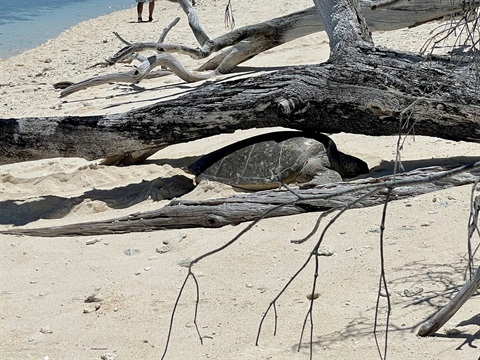Keep turtles in mind during nesting and hatching seasons
Published on 14 October 2025

Council is reminding residents that nesting season for turtles has begun and to be diligent and cautious when visiting our region's beaches.
Six of the world’s seven species of marine turtles visit coastal waters of the Gladstone Region at various times of the year, with three species known to nest on our beaches.
Female turtles are expected to come ashore between now and January to lay their eggs.
Gladstone Region Mayor Matt Burnett said nesting turtles make their way ashore to lay their eggs at night, with evidence of turtle nesting observed during the day.
“If beach goers come across a nesting turtle, we ask you observe them from a distance as they are timid and easily disturbed,” Mayor Burnett said.
“The entire nesting process can take several hours and once the turtle has finished laying eggs it returns to the ocean.
“The nest is then incubated for approximately six weeks, after which the hatchlings will emerge as a group.”
Turtle hatching season is expected to occur from January to March.
“Turtle hatchlings are guided to the ocean by following the lowest bright horizon, so it’s important to reduce the use of artificial lights on the beach, such as torches or flash photography, so they don’t become disorientated on their journey to the ocean,” he said.
“We also ask that when driving on beaches where vehicles are permitted to only drive on the hard sand below the high-tide mark to avoid interfering with turtle nests.
“Dog owners are reminded that certain Agnes Water beaches are dog-free zones between November to March including Chinaman’s Beach, Springs Beach and Red Rock Beach.”
In addition to the above precautions, Mayor Burnett is encouraging residents who live in close proximity to turtle nesting beaches to participate in Turtle Hour on Monday 20 October.
“Turtle Hour will take place between 7-8pm on 20 October and encourages residents and businesses to turn off their lights for one hour,” he said.
“Artificial light from houses, neighbourhoods and business creates a collective glow that can stop mother turtles from nesting, so it’s not only a way to save some money on your electricity bill, it also helps to grow and nurture our precious turtles.”
If you observe turtle tracks or a nesting turtle, please report your sighting to the relevant group:
- From Seventeen Seventy south to Chinaman’s Beach, you can text the location (coordinates) and photo to the Agnes Conservation Community (ACC) on 0427 358 201
- For sightings from Springs Beach south to Red Rock, text the location (coordinates) and photo to the Turtle Action Group (TAG) on 0416 257 754
- For sightings at Rules Beach, text the location (coordinates) and photo to Rules Beach Turtle Monitoring on 0413 488 993.
To report a sick, injured or dead turtle, phone the Queensland Government Wildlife Hotline on 1300 130 272 or use the QWildlife app – available for free on Google Play (Android devices) or the App Store (Apple devices).
Visit www.gladstone.qld.gov.au/wildlife for more information on what Council is doing to protect marine turtles and their habitat.